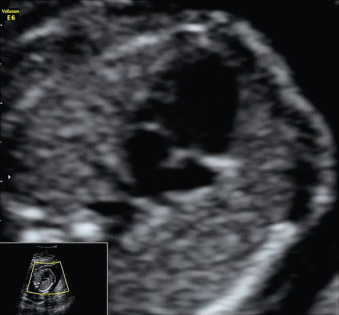Abstract
Double-inlet single ventricle is a rare anomaly that comprises a heterogeneous group of cardiac anomalies characterized by the presence of two atria with a single ventricle. The prognosis is usually very poor, and univentricular surgery is required.
Keywords
congenital heart disease, single ventricle, univentricular cardiac surgery
Introduction
Double-inlet single ventricle is a rare anomaly, accounting for 2% to 3% of all congenital heart diseases (CHDs). Double-inlet single ventricle comprises a heterogeneous group of cardiac anomalies characterized by the presence of two atria with a single ventricle. Cardiac and extracardiac anomalies are commonly associated. The prognosis is usually very poor, and univentricular repair is required.
Disease
Definition
Double-inlet single ventricle comprises a heterogeneous group of cardiac anomalies characterized by two atria and a single ventricle with one or two atrioventricular valves. Although a rudimentary accessory ventricle may also exist, only one ventricle is functional, receiving the flow from both atria. This entity does not include cases with a single functional ventricle secondary to mitral or tricuspid atresia.
Prevalence and Epidemiology
Double-inlet single ventricle is a rare anomaly. It occurs in approximately 0.5 : 10,000 to 1.0 : 10,000 live births and accounts for 2% to 3% of all CHDs.
Etiology and Pathophysiology
The morphologic spectrum of double-inlet single ventricle is broad, with a variety of segmental patterns and anatomic variables, including differences in anatomic pattern of the single ventricle (left, right, or indeterminate); the sizes of the atrioventricular valves or atresia of one atrioventricular valve; variable ventricular looping and ventriculoarterial relationship; and obstruction to systemic or pulmonary outflow (or both systemic and pulmonary outflow). The most common form is a single left ventricle with a rudimentary right ventricle, two atrioventricular valves, and aorta disposed anteriorly and to the left of the pulmonary artery.
Other cardiac (valvular atresia or stenosis or coarctation of aorta) or noncardiac (heterotaxia, cystic hygroma, congenital diaphragmatic hernia) anomalies are frequently associated. Chromosomal anomalies may be also associated (trisomy 18, Klinefelter syndrome, DiGeorge syndrome, or Goldenhar syndrome).
Manifestations of Disease
Clinical Presentation
Double-inlet single ventricle typically appears as a single ventricle on the anatomic ultrasound (US).
Imaging Technique and Findings
Ultrasound.
The diagnosis is suspected on the four-chamber view with one single ventricle receiving flow from both atria ( Figs. 89.1 and 89.2 , and ). A rudimentary ventricle not receiving flow may also be present.











